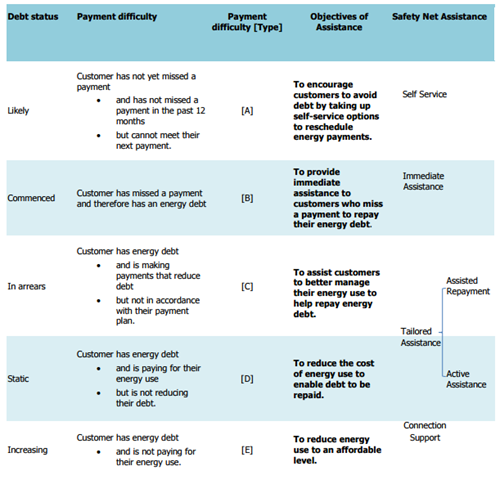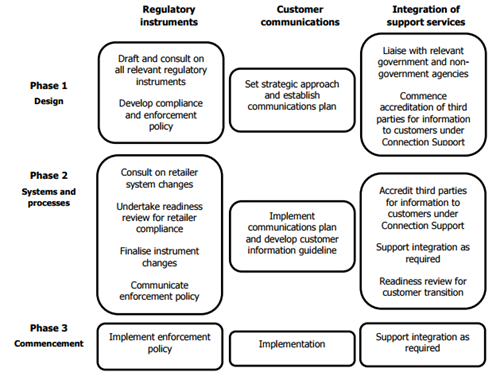New framework comes into the picture
After a year of consultation, Victoria’s Essential Services Commission’s (ESC) final report on its hardship inquiry was tabled in State Parliament on Tuesday. It looked at how energy retailers support consumers who experience difficulties paying their bills.
The report, “Supporting customers, avoiding labels”, proposes a new framework for hardship in Victoria and focuses on the scope of assistance offered by retailers, delivery of customer assistance, monitoring and reporting.
The ESC work has highlighted the complexity and challenge of identifying and then providing timely assistance to consumers who genuinely need support to manage their energy bills. Ultimately, hardship and affordability issues are a shared responsibility between industry, the government (which provides concessions) and consumer and welfare groups, who can help with better targeting of support.
The ESC is now looking at designing and revising regulatory instruments, such as new interim payment plan performance indicators, a consumer energy code on payment difficulties, new industry guidelines, revising disconnection operating procedures and Guaranteed Service Levels.
The framework is set to be implemented on 1 July 2017. From now until then, there is still a comprehensive amount of consultation to be undertaken with the Commission, government, industry and consumer groups to go through the practical implementation to transition to the proposed framework.
The stated purpose of the new framework is to assist customers experiencing difficulty to avoid long-term debt, repay debt that accrues, while, wherever possible, maintaining access to power.
In making the case for a new framework, the ESC has argued that the previous hardship programs have been “too often, and increasingly so, hardship programs simply provide a stepping stone towards disconnection rather than an avenue away from it”.
It points to the most recent available data for 2013-14 which showed 58,503 customers were disconnected for non-payment of energy bills[i].
Disconnection remains an option of last resort for energy companies and when considering the disconnections for customers on instalment plans and those experiencing multiple disconnections within two years (which are used as indicators of those in financial difficulty) these have trended down[ii].
The ESC acknowledged this in its report, but also commented that the fall in the number of customers who had multiple disconnections over two years that they are able to arrange an instalment plan to avoid future disconnection.
To meet the Government’s policy expectation of “wherever possible, energy consumers remain connected to supply, and that disconnection of customers is only used as a measure of last resort”, the ESC framework involves:
- A self-service option - this is where a customer who has not yet missed a payment but anticipates having trouble paying their energy bill, can contact their retailer to go on a payment plan.
- Immediate Assistance – automatically placing customers who miss a payment on to a monthly payment plan with the amount of monthly debt repayment capped. Automatically placing customers onto a payment plan has been subject to much debate with concerns that because it occurs at a very early stage in the payment cycle it could capture a larger number of customers, including those who do not need immediate financial or payment assistance and that it will not encourage early consumer engagement.
- Tailored Assistance via: Assisted repayment – which gives consumers the chance to extend their debt repayment schedule when they are having trouble meeting their payment plan; Active assistance – for customers who have incurred energy debt, who can pay for their ongoing energy use, but cannot make their debt repayments. It is aimed at reducing energy consumption with the savings being used to repay the consumer’s debt.
- Connection support – this is a last resort option to avoid disconnection. In the first three months a customer will have a fixed payment plan that is below the cost of their energy use. During this period the retailer will need to help the consumer reduce their energy consumption and access community and welfare support. If after three months the consumer is still not paying for their energy use they will have to move to a “pay-as-you-go” arrangement to stay connected.
The scope of assistance is outlined in the report and shown here:

The ESC points to the addition of two new protections for consumers under its framework, specifically automatically putting consumers onto a payment plan and the use of prepayment plans in the final stage as “an ultimate safety net”.
The ESC believes a retailer should be able to consider disconnecting a consumer if:
- The customer doesn’t make the payments under a relevant payment plan, and
- The customer doesn’t engage with their retailer to make new arrangements, and
- The retailer can demonstrate that is had provided all required assistance, or
- It has used its best endeavours to do so.
The final report has set out an implementation roadmap for the framework which is shown below:

Related Analysis
Consumer Energy Resources: The next big thing?
The Consumer Energy Resources Roadmap has just been endorsed by Energy and Climate Change Ministers. It is considered by government to be the next big reform for the energy system and important to achieving the AEMO’s Integrated System Plan (ISP). Energy Minister, Chris Bowen, recognises the key will be “making sure that those consumers who have solar panels or a battery or an electric vehicle are able to get maximum benefit out of it for themselves and also for the grid”. There’s no doubt that will be important; equally there is no doubt that it is not simple to achieve, nor a certainty. With the grid intended to serve customers, not the other way around, customer interests will need to be front and centre as the roadmap is rolled out. We take a look.
Green certification key to Government’s climate ambitions
The energy transition is creating surging corporate demand, both domestically and internationally, for renewable electricity. But with growing scrutiny towards greenwashing, it is critical all green electricity claims are verifiable and credible. The Federal Government has designed a policy to perform this function but in recent months the timing of its implementation has come under some doubt. We take a closer look.
Energy regulation: A tale of increasing overload?
The energy sector is seeing an increase in regulation, with the retail laws and rules seemingly being changed year on year. This has led to old, overlapping or obsolete regulation not being removed, making it difficult for retailers to comply with, and regulators to enforce these rules and laws. We take a look at how overregulation is affecting customers and the cost of electricity.
Send an email with your question or comment, and include your name and a short message and we'll get back to you shortly.


